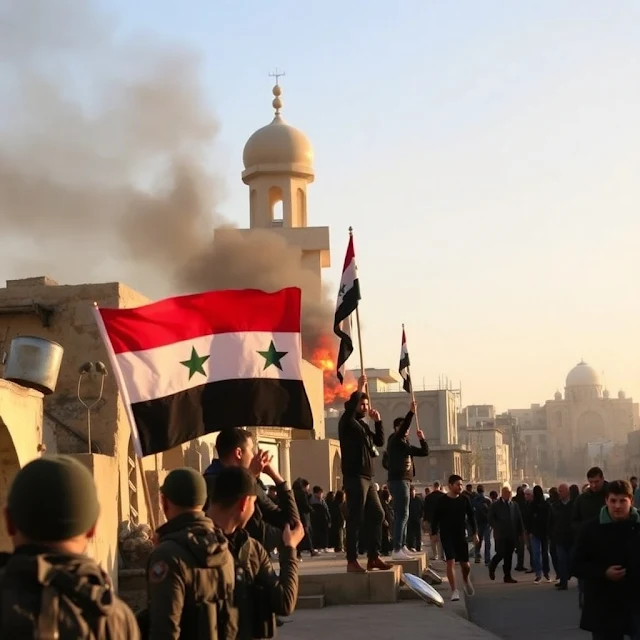Eight years after Syrian President Bashar al-Assad reclaimed Aleppo with significant Russian support, a dramatic reversal has taken place. Last week, in just over 72 hours, a coalition of Syrian rebel groups operating under the banner of “Deterrence of Aggression” seized control of Aleppo, Syria’s second-largest city, in a surprise offensive. This victory marks a significant escalation in the conflict, which had largely simmered in recent years, and a major blow to Assad’s forces.
The coalition, composed of well-established Islamist factions, has a shared goal of fighting Assad, ISIS, and Iran-backed militias. Here’s a closer look at the key groups involved:
Hayat Tahrir al-Sham (HTS)
The most prominent group in the coalition is Hayat Tahrir al-Sham (HTS), also known as the Organization for the Liberation of the Levant. HTS was founded by Abu Mohammad al-Jolani, a former al-Qaeda operative who gained military experience during the U.S. invasion of Iraq. Jolani later led al-Qaeda’s Syrian affiliate, Jabhat al-Nusra, until splitting from the organization in 2016 due to ideological differences and opposition to ISIS. In 2017, he established HTS.
Despite efforts by Jolani to distance HTS from al-Qaeda and ISIS, the group remains designated as a Foreign Terrorist Organization by the United States and other Western nations. Jolani himself has a $10 million bounty on his head.
HTS’s power base lies in Idlib, a densely populated area in northwestern Syria that became a haven for displaced Syrians after years of conflict. Under Jolani’s leadership, HTS has become a dominant force, controlling much of Idlib’s economy and infrastructure.
“(HTS) has been able to build that empire by primarily controlling most of the economic sectors in Idlib. … They are more of an independent force than many groups,” said Natasha Hall, a senior fellow at the Center for Strategic and International Studies (CSIS).
HTS played a pivotal role in last week’s Aleppo offensive, signaling its continued strength despite internal rivalries and past setbacks, including the loss of Aleppo to Assad’s forces in 2016.
The Syrian National Army (SNA)
Another key participant in the Aleppo offensive is the Syrian National Army (SNA), a Turkish-backed umbrella group composed of numerous factions with varying ideologies. One of the SNA’s most notable subgroups is the National Liberation Front, which includes Ahrar al-Sham, an Islamist faction that aims to overthrow Assad and establish an Islamic state governed by Sharia law.
While Ahrar al-Sham is considered moderate compared to groups like HTS, its Islamist orientation remains a defining feature. Following Aleppo’s capture, Ahrar al-Sham’s deputy commander, Ahmed al-Dalati, issued instructions to protect the city’s ethnic and religious minorities.
“The instructions of the general command… are strict and clear. It is forbidden to harm anyone or encroach on their property… not just Muslims, but everyone else, whether Christians or Armenians or any sect present in Aleppo,” Dalati announced in a public address.
Turkish Influence and Kurdish Tensions
The SNA’s reliance on Turkey has complicated its mission. Turkey has long supported Syrian rebel factions, but its primary focus has often been on suppressing Kurdish forces rather than targeting the Assad regime. This dynamic has drawn criticism from analysts who argue that Turkey’s priorities are diverting Syrian rebels from their original objectives.
“Being entirely reliant on Turkey, rather than fighting the good fight for the Syrian people they’re fighting the fight for the Turkish government,” said Natasha Hall. “They have set their targets on Kurdish-controlled areas rather than the (Assad) regime, which is what all these groups and fighters had initially been fighting.”
Turkey has conducted multiple military operations against the Kurdistan Workers’ Party (PKK), which it designates as a terrorist organization, and related Kurdish groups in Syria. This has created friction between Turkey-backed factions and other opposition groups more focused on Assad’s regime.
Implications of Aleppo’s Fall
The fall of Aleppo represents a significant escalation in the Syrian conflict and raises questions about the future trajectory of the war. For Assad, the loss is a major setback, undermining years of effort to consolidate power. For the rebels, it is a morale-boosting victory, demonstrating their ability to mount coordinated operations despite years of internal divisions and external pressures.
However, the coalition’s long-term stability is uncertain. HTS and SNA have divergent goals and allegiances, which could hinder their ability to sustain their gains in Aleppo. Furthermore, the presence of external powers—namely Turkey—adds another layer of complexity to the conflict.
As the situation unfolds, the capture of Aleppo serves as a stark reminder that Syria’s civil war, though quieter in recent years, is far from over. The dynamics between rebel factions, Assad’s regime, and international stakeholders will continue to shape the country’s future.

















.jpeg)

0 Comments